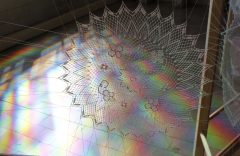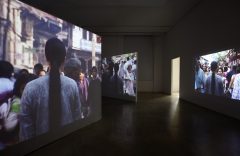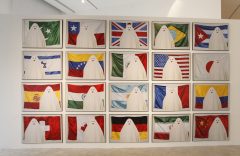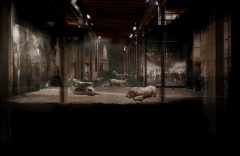
The artist and scholar provided a lesson dedicated to collage and its pedagogical potential for educators of cultural spaces and institutions of initial, primary and secondary level.
Eduardo Stupía began the Visual Arts Teacher Training Program promoted by the MUNTREF with a class dedicated to the pedagogical potential contained in collage, one of the visual arts formats with which we get familiar with at an early age.
“For those who are learning as well as for teachers and for those who are in charge of the development of a group of students at a certain level, collage is extraordinarily productive and very revealing, not only of virtues but of problems and working hypotheses in the field of language”, asserted the artist about its qualities.
Stupía highlighted, above all, its accessibility. “It is the most democratic and universal tool and system in the sense that you just have to know how to cut and paste. While still babbling in some other language, the collage is immediately feasible and also emits a signal that helps the cognitive”, he defined.
In addition to its transversal nature, the renowned visual artist pointed out that collage serves to think about historical contexts and the realities in which we find ourselves immersed.
“The collage and the world have a kind of mimetic empathy relationship, the images of the world appear in the collage with an extraordinary multiplicity as well as segments of much imagery. But in many cases the reflection of the living time period appears very strongly in the field of collage with this heterogeneity”, he explained.
Thus, in his presentation he referred to the beginnings of this artistic expression and how it managed to capture a certain period spirit. As he pointed out, it was the cubists Pablo Picasso and Georges Braque who around 1912 made the first collages with scraps from the written press.
“The appearance of the newspaper is very important because it was unusual at the time that materials from everyday life were attached to painting. They used them as a visual element, as color and texture, but also because the newspaper had, at that time, an extraordinary importance”, he explained, adding that those were the years of the Belle Époque and the irruption of industriality, of the big cities, the discovery of leisure and an unprecedented scientific and technological development.
“At that time the readability of a piece of paper was an important graphic element, but also a critical comment. In many cases the legible parts of these pieces belonged to the various facts section that the newspapers brought at that time, banal, everyday and sensational facts. There was a legible intentionality, not just chromatic”, he furthered.
In addition, he looked at how these initiators of collage raised a real break in the field of painting, and exemplified with a work by Picasso in which he uses a cardboard from an underwear house as a base. “At that time, the entry into painting of a degraded materiality was quite revolutionary, painting still had great prestige, this was a kind of blasphemy, it is the beginning of the avant-garde break”, he described.
Stupía also went through other variants such as political collage, which would later arrive together with the technological changes with references such as John Heartfield. “That’s when the issue of photomontage begins, which is the first technological form of collage, where the photographs, their cuts, various overlays and their intentional alteration are in favor of an ideological message”, he explained, showing several of Heartfield’s anti-Nazi compositions.
He also delved into other artists’ works who used waste for their collages, thus generating some comments on the environmental issue and capitalism. Among them, he mentioned Kurt Schwitters, who according to Stupía began to work on them when the world’s industrialization was generating waste.
“It had a hyper-contemporary and trash quality, at a time when the formalism of art excluded the question of discarding. In the collage, the surplus, the surplus of capitalist society, is production material”, he assured.
Stupía emphasized that this format survives the changes of time and its different artistic scenes, where today, for example, there are forms such as digital collage, which, however, is not at all alien to its previous forms.
“Collage is the procedure of absolute multiplicity, with more or less simple, physical elements, to which are added intangible elements that were developed throughout the history of technology and that have transformed it. Collage continues to be cut and paste, it is the antecessor of one of the functions of the digital semantic apparatus, its cut and paste”, he considered.
Stupia emphasized that collage’s persistence lies in its ability to generate empathy and its referentiality. “Collage is always attractive, it allows us to enter. The signal that it emits beyond how strange it seems to us is always magnetic, it is pulling us inwards, and I think that has to do with the fact that we recognize its elements as part of the reality that surrounds us”, he reflected.
The Visual Arts Teacher Training Program, coordinated by Paula Hyrcyk, is a free training space aimed at teachers, management teams and supervisors of formal education institutions (initial, primary and secondary) and non-formal education institutions throughout the country. The program, which will consist of five meetings coordinated by Vali Guidalevich and Valeria Traversa, seeks to be an area of experimentation, exchanges and learning of the visual arts that allows the establishment of interdisciplinary conceptual networks, intertwining both theory and practice. The initiative will continue with another four meetings dedicated to thinking about writing and art, installations, art and politics, and curatorship and exhibitions.
News











